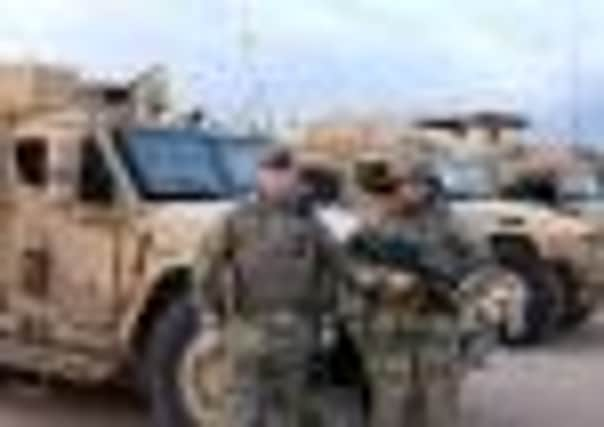On patrol in a part of Norfolk that is forever Afghanistan


To our right is a forest strewn with Improvised Explosive Devices (IEDS) and teeming with heavily armed insurgents.
As darkness falls, Regimental Sergeant Major Darren Szymanski of 3rd Battalion, The Yorkshire Regiment, brings down the vehicle’s night vision screens while a soldier manning the machine gun turret scans the road ahead.
Advertisement
Hide AdAdvertisement
Hide AdSuddenly, a shape appears and we screech to a halt. The startled eyes of a lost pheasant glint in the night vision cameras.
After a brief silent stand-off between the bird and the soldiers manning more than half a million pounds worth of Ministry of Defence (MoD) machinery, it regains its composure and scurries back under a bush.
It is a rare English invasion at the Stanford Area in Norfolk, where the MoD has created a miniature Helmand Province complete with nearly 300 Afghan nationals, a £14m village, specially planted green zones and forward operating bases replicating those where soldiers will be stationed during their tour in Afghanistan.
The exercise is run by veterans with recent experience of the conflict who throw everything at the soldiers from Rocket Propelled Grenade (RPG) strikes to suicide bombers, 24 hours a day.
Advertisement
Hide AdAdvertisement
Hide AdThe grass may be greener than Helmand and weather more temperate, but make no mistake about it - this is a war zone.
I am stationed here with the 3rd Battalion as it prepares for its expected first full tour to Afghanistan as part of a battle group next year. The battalion has already endured a number of deaths and casualties during the conflict and is braced to be deployed to one of the most hotly contested parts of Helmand Province. It has been posted for a week to the training area, a 30,000 acre live fire site which covers two per cent of Norfolk, as the culmination of its pre-deployment training.
We arrive at our designated pick-up point in the rain long after dark near one of the forward operating bases where Burma Company are stationed. A platoon of heavily armed soldiers appears out of the shadows and I am marched back to the compound.
It had come under attack a few minutes ago and is a hive of activity.
Advertisement
Hide AdAdvertisement
Hide AdInside the comms room, a tangled mass of wires, radios and laptops with screens streaming footage from unmanned drones circulating above, Major Rob Singleton, Officer Commanding of Burma Company, is planning the next morning’s activity where he has been invited to a meeting with the head of the local police.
“We are getting everything thrown at us,” he said. “We are facing some pretty tricky moments but we have to experience these in as realistic environment as possible to prepare us for going on operations.”
Shortly before midnight, I visit one of the sentry posts and as we scan the fields through night vision telescopes, loud gunfire crackles through the night. A soldier in a nearby sentry post has been deemed shot by the insurgents and is flown by helicopter back to the main base.
A few of us head to bed - a frozen wood floor shared by groups of 10 or more soldiers - or the tents outside. Most stay awake on guard throughout the night.
Advertisement
Hide AdAdvertisement
Hide AdBreakfast is at 5.30am sharp, with fried slices of spam, porridge and beans ladled out by the cook house chefs, before we head out on patrol.
Soldiers have been posted around the village to secure the area while Major Singleton attends the meeting.
I am in a platoon in a forest overlooking a bridge.
Activity crackles over the radio and all around; small arms fire, IEDs discovered, Chinooks whisking injured soldiers away and the endless drone of Apache and Merlin helicopters.
But for us, all is quiet.
We keep our position for six hours with no rations, stamping our feet and smoking endlessly in a vain effort to stay warm, before we are finally called back to base.
Advertisement
Hide AdAdvertisement
Hide AdNot long after we arrive, a civilian car hits an IED planted outside, sending the camp into disarray.
As soldiers stream out to secure the area, I quietly head the other way.
Reg Sgt Maj Szymanski is waiting for me around the corner, this time in a white van.
As we drive, the chaos of Helmand melts back into the English countryside.
Already, it seems a different world away.